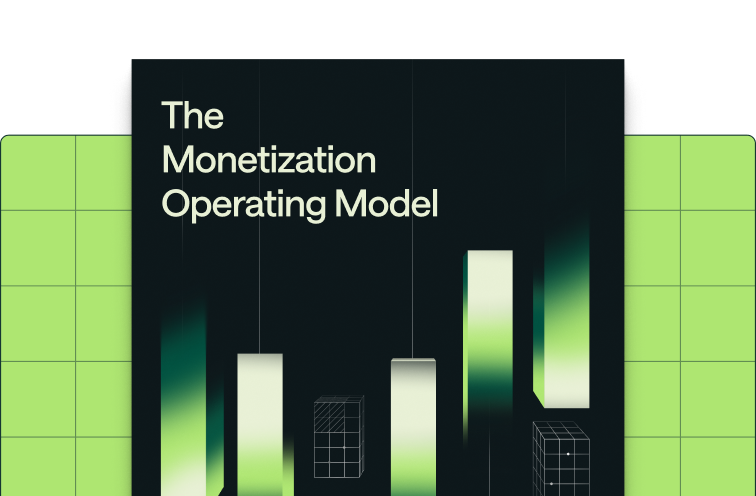Share
Software companies are shifting from flat subscriptions to usage-based pricing.
Why?
Because traditional subscriptions treat all customers the same, regardless of how much value they extract. A customer generating thousands of API calls pays the same as one generating just a few.
This misalignment becomes especially pronounced with AI features, where value delivery varies dramatically. Some customers get $10 worth of value, others get $10,000, but subscription pricing can't capture that difference.
Beyond value alignment, AI's variable cost structure makes flat pricing financially risky. When your serving costs directly correlate with customer usage, usage spikes under fixed subscriptions can quickly erode margins.
But making this transition requires fundamentally different billing infrastructure. Subscription systems weren't designed for variable usage patterns, real-time metering, or complex pricing tiers that usage-based models demand.
Most companies discover this when they try to add usage components to their existing subscription setup. Product teams build consumption-based features, but finance can't launch them because their billing system can't track or price usage accurately. Engineering teams spend months building custom metering solutions instead of focusing on product development.
Here's all you need to know about whether usage-based pricing is right for you and how to navigate that transition.
What is usage-based pricing?
Usage-based pricing charges customers based on their actual consumption of your product.
Unlike subscriptions, where everyone pays the same regardless of usage, usage-based pricing scales with customer value. A customer making 10 API calls pays differently from one making 10,000 calls.
The billing directly reflects how much they use and, theoretically, how much value they extract.
Usage-based pricing works especially well for:
- AI and machine learning products where value varies dramatically by consumption
- Infrastructure and developer tools where usage scales with customer growth
- Products with clear, measurable units that correlate with customer value
- Companies wanting to reduce barriers to entry while capturing upside from heavy users
The model can be pure usage-only, but more commonly appears as hybrid pricing, combining base subscriptions with usage charges.
This gives customers predictable base costs while allowing pricing to scale with actual consumption.
The challenge with usage-based pricing is operational. Usage-based pricing requires infrastructure to track granular usage in real-time, apply complex pricing tiers, and bill accurately for variable consumption patterns.
Most subscription billing systems weren't built for this level of complexity.
{{widget-monetization-whitepaper}}What are subscription models?
Subscription models are a type of flat-rate pricing that charge customers a fixed, recurring fee, usually monthly or annually, for access to your product, regardless of how much they actually use it.
Everyone pays the same amount for the same plan, whether they're a power user or log in once a month.
This was the dominant SaaS pricing model for good reason. Subscriptions create predictable recurring revenue, simplify billing operations, and reduce customer acquisition friction with transparent, upfront pricing.
Subscription models work well for:
- Products where value is tied to access rather than consumption
- Companies prioritizing predictable revenue and cash flow
- Markets where customers prefer cost certainty over variable pricing
- Products with relatively uniform usage patterns across customers
- Businesses focused on simplifying billing operations and customer experience
The challenge with subscriptions is value misalignment.
Heavy users get a great deal while light users overpay. For products where usage varies dramatically — especially AI and infrastructure tools — this creates pricing pressure from both directions.
Most subscription billing systems were designed for this predictable, recurring model. They handle seats, plans, and billing cycles well, but struggle with variable usage patterns, real-time metering, and complex pricing tiers that modern products increasingly need.
Many companies now run hybrid models, combining subscription bases with usage charges, but this creates operational complexity when billing systems weren't designed to handle both simultaneously.
Usage-based pricing vs. subscription models: pros and cons
Usage-based pricing and subscriptions are two of the most common pricing models in SaaS, but they operate on different assumptions about value, growth, and billing behavior.
The fundamental difference is architectural.
Subscription systems work well for predictable, access-based products but break down when usage varies significantly.
Usage-based pricing requires infrastructure that can meter granular consumption, apply pricing logic, and handle variable billing amounts in real-time.
Here are the pros and cons of each pricing model at a glance:
Many companies adopt hybrid models, combining base subscriptions with usage charges, to balance revenue predictability with usage-aligned growth.
However, this often creates operational complexity when billing systems weren't designed to handle both models simultaneously.
Determining whether usage-based pricing is right for you
To evaluate whether usage-based pricing fits your business, look at three areas: how your product delivers value, how your customers behave, and whether your organization can support the operational shift.
Does your product deliver variable value?
Usage-based pricing works best when customers consume the product in different amounts and receive value proportional to that consumption.
Ask:
- Do some customers use 10x more of your product than others?
- Can usage be cleanly measured (e.g., events processed, API calls, storage used)?
- Is there a clear link between usage and customer outcomes?
If value scales with usage, usage-based pricing creates a more accurate and defensible pricing model.
Will your customers understand and accept usage-based pricing?
Consider how your buyers make decisions and manage budgets.
Ask:
- Do your customers already use metered services (e.g., cloud compute, SMS, payments)?
- Are they comfortable with variable costs, or do they need predictable pricing?
- Can you provide transparency for them to see and manage spend (e.g., dashboards, usage alerts, cost estimates)?
If your customers value flexibility and already expect usage-based pricing in adjacent tools, you’re more likely to see strong adoption.
Can your team support the operational shift?
Usage-based billing introduces new requirements across finance, product, and engineering.
Ask:
- Can your product and data teams instrument clean, customer-level usage tracking?
- Does your billing system support usage attribution, pricing logic, and reporting?
- Can finance forecast variable revenue and close the books without manual work?
If your infrastructure can’t support this today, you may need to phase in usage gradually or upgrade systems before going live.
How to transition from subscriptions to usage-based billing in 6 steps
Rethinking your pricing model requires re-evaluating your billing systems — unless you want to spend months manually stitching together incompatible systems.
This six-step framework helps you design a billing foundation that matches how your product delivers value, so you can scale usage-based revenue without operational drag.
1. Align leadership around a shared value metric
Shifting to usage-based pricing requires leadership alignment around a single value metric that reflects real product usage and scales with customer success. That alignment needs to span finance, product, sales, and customer success because it shapes forecasting, incentives, and product strategy.
Usage-based billing only works when the entire organization shares a common understanding of what drives customer value. In many companies, pricing is still tied to what’s easy to measure, like seats or tiers, rather than how customers actually use the product.
Start identifying a shared value metric by asking:
- What action or behavior best represents the value customers get from the product?
- Can that behavior be tracked consistently and attributed to specific customers?
- Does it scale naturally as customers grow?
Teams that skip this step often run into misaligned pricing, internal friction, and unpredictable revenue patterns. Getting the value metric right — and aligned across the business — sets the foundation for every decision that follows.
2. Choose the right value, usage, and billable metrics
Once leadership aligns on the value your product delivers, the next step is defining how to measure and monetize that value.
This means translating your strategy into three core metrics: the value metric, the usage metric, and the billable metric.
- The value metric is the foundation. It defines what customers perceive as valuable or what they’re actually paying for. It should correlate directly with product outcomes and scale as customers grow.
- The usage metric is how that value shows up in the product. It tracks real behavior like messages sent, files processed, or compute hours used. These are often logged in your app but not yet structured for billing.
- The billable metric is the surface area of pricing. It defines how charges are calculated and presented. You might choose to bill per unit, offer prepaid credits, or bundle usage into tiers. The right structure depends on customer expectations, sales motion, and technical feasibility.
Most companies moving from subscriptions already have usage data. They just aren’t using it to power billing yet. The challenge is identifying which metrics to keep, which to refine, and how to map them to a pricing model that’s both accurate and easy to explain.
This is where systems like Metronome add leverage. By separating these three metric layers and connecting them through APIs, you can evolve pricing logic without overhauling your data model or dragging engineering into every decision.
3. Build systems that can operationalize your pricing model
Once your metrics are defined, your systems need to support them end to end, from usage tracking to billing to revenue recognition. Most subscription billing platforms aren’t designed to process real-time consumption, flexible pricing logic, or hybrid models at scale.
To run usage-based billing reliably, your infrastructure should:
- Stream usage data from your product or warehouse
- Attribute usage to specific customers and billing periods
- Apply pricing logic through configuration, not code
- Automate invoicing, revenue recognition, and reporting
This step establishes the foundation for accurate billing, scalable operations, and faster pricing iteration. Metronome supports this shift by integrating with your existing systems, handling event volume at scale, and giving business teams the tools to manage pricing directly.
Once your systems are set up to track usage, apply pricing logic, and generate invoices, you’re ready to start testing that end-to-end workflow with real customer data.
4. Test your usage-based billing workflows
Before rolling out usage-based pricing broadly, test your entire billing workflow in a controlled environment. This step helps surface operational issues, validate pricing logic, and give internal teams the confidence to support the new model.
Choose a limited group of customers, such as new accounts, specific geographies, or friendly early adopters. Run live usage data through your billing system and monitor how it flows from event tracking to invoice generation and revenue reporting.
During this test, confirm that:
- Usage events are captured consistently and attributed correctly
- Charges match the configured pricing model
- Invoices are clear, accurate, and aligned with customer expectations
- Internal reporting reflects usage-based revenue without manual adjustments
Use this phase to gather feedback from finance, customer success, and support. Track where confusion or inefficiencies emerge, especially in billing transparency, rate comprehension, and edge-case usage scenarios.
Metronome helps teams monitor usage ingestion, apply pricing logic, and generate billing outputs in real time. You can integrate usage and billing data into dashboards, reporting systems, or customer-facing tools to spot errors early and track trends.
This phase turns your pricing model into a working system, proven at a small scale and ready for expansion.
5. Finalize your rollout and communicate with customers
Once your usage-based billing system is tested and stable, roll it out to your full customer base with a clear communication plan. This phase is where trust, transparency, and predictability matter most.
Start by setting a firm transition timeline. Define who’s moving to usage-based pricing, when it will take effect, and what changes they can expect. Tailor the rollout by segment since some customers may need a longer lead time or contract-based accommodations.
Equip customers with the tools and context they need to understand the new pricing model:
- Explain how charges are calculated and what metrics are being used
- Provide real examples or benchmarks to help them forecast costs
- Link to help docs, FAQs, and customer support for deeper questions
Visibility is essential. Metronome supports this by pushing usage and billing data into customer dashboards, so users can track their consumption and spending before invoices arrive. Alerts, budget thresholds, and custom reports help teams manage spend proactively.
Make sure internal teams are fully trained. Sales, success, and support should all have access to usage metrics, pricing logic, and standard answers to common billing questions.
This step ensures that your rollout lands cleanly, minimizing confusion, enabling self-serve billing visibility, and keeping customers informed every step of the way.
6. Continue to learn and iterate
Usage-based billing isn’t a set-it-and-forget-it system. Once your new model is live, you’ll need to revisit your metrics, pricing logic, and customer experience regularly to keep everything aligned with how value is delivered.
Monitor how usage trends evolve. Look for signs that your value metric still reflects what customers care about and whether your pricing captures that value effectively. If customers cluster around free allowances or spike unpredictably into overage territory, revisit your billable metric or rate structure.
Track operational performance across billing accuracy, finance workflows, and reporting. Manual work should decrease over time. If it doesn’t, investigate where friction still exists in data ingestion, pricing logic, or invoicing.
Build in regular feedback loops with customer-facing teams. What are customers asking about? Where are support tickets spiking? What do sales teams need to close usage-based deals more effectively?
Metronome gives your team the ability to adjust pricing configuration, monitor usage patterns, and update billing logic without writing code. That flexibility supports continuous improvement, whether you’re refining tiers, testing new metrics, or rolling out packaging changes to new segments.
This final step ensures your pricing stays flexible, your systems stay reliable, and your customers keep seeing a clear link between what they pay and what they get.
Making the shift to usage-based pricing work
Usage-based billing reshapes how your business operates. It supports faster product launches, aligns pricing with value delivered, and creates a more scalable revenue foundation.
Whether you're moving to pure usage-based pricing or adding usage components to existing subscriptions in a hybrid model, the operational challenges are similar.
This six-step framework gives your team a clear path forward:
- Figure out where your product creates value
- Define metrics to track
- Build a system that supports those metrics
- Test your changes
- Finalize your rollout and communicate with customers
- Learn and iterate
Each step improves clarity, reduces operational risk, and increases control over how revenue is measured and realized.
Finance teams play a central role in driving this shift. Pricing changes depend on how value is defined, how usage is measured, and how revenue is reported across the organization.
With the right systems and alignment in place, teams can launch new pricing quickly, generate accurate invoices, and forecast revenue with confidence. Usage-based billing becomes a long-term advantage when every part of the business is built to support it.
{{widget-monetization-whitepaper}}






%2520(1)%2520(1).png)

.avif)

